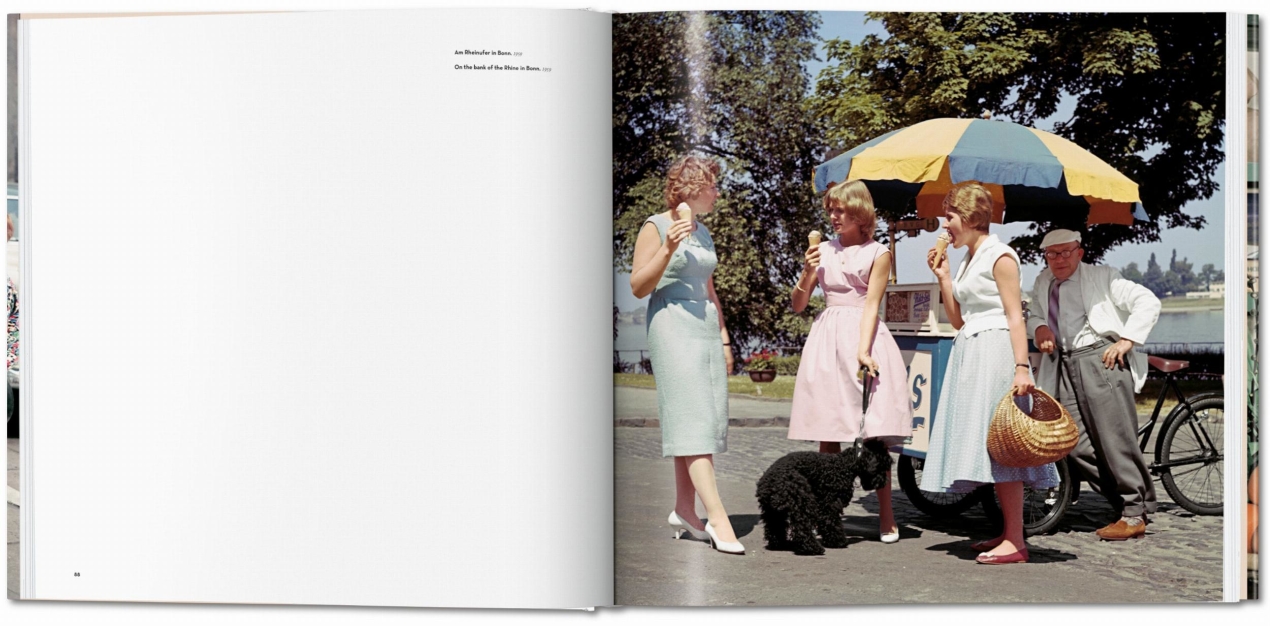1 / 9
Josef Heinrich Darchinger. Wirtschaftswunder
60
Documento visivo fondamentale della storia tedesca, il portfolio di Josef Darchinger sulla Germania occidentale del dopoguerra rivela un'epoca straordinaria, in bilico tra l'aumento del benessere e la continua penuria, tra luoghi bombardati e nuove costruzioni, tra la Gemütlichkeit tedesca e la nuova minaccia della Guerra fredda.
Copertina rigida, 11.5 x 11.5 in., 5.95 lb, 292 pagine

Josef Heinrich Darchinger. Wirtschaftswunder
60Miraculous Recovery
Picking up the pieces in postwar Germany
It was no more than eight years after the surrender of the Nazi government when Josef Heinrich Darchinger set out on his photographic journey through the West of a divided Germany. The bombs of World War II had reduced the country’s major cities to deserts of rubble. Yet his pictures show scarcely any signs of the downfall of a civilization. Not that the photographer was manipulating the evidence: he simply recorded what he saw. At the time, a New York travel agency was advertising the last opportunity to go and visit the remaining bomb sites. Darchinger’s pictures, in color and black-and-white, show a country in a fever of reconstruction. The economic boom was so incredible that the whole world spoke of an “economic miracle.” The people who achieved it, in contrast, look down-to-earth, unassuming, conscientious, and diligent. And increasingly, they look like strangers in the world they have created.
The photographs portray a country caught between the opposite poles of technological modernism and cultural restoration, between affluence and penury, between German Gemütlichkeit and the constant threat of the Cold War. They show the winners and losers of the “economic miracle,” people from all social classes, at home, at work, in their very limited free time and as consumers. But they also show a country that looks, in retrospect, like a film from the middle of the last century.
For this revised edition, we have digitally remastered all photographies in a new, full-frame format that captivate with their highly pigmented colors and fine press varnish.
The photographs portray a country caught between the opposite poles of technological modernism and cultural restoration, between affluence and penury, between German Gemütlichkeit and the constant threat of the Cold War. They show the winners and losers of the “economic miracle,” people from all social classes, at home, at work, in their very limited free time and as consumers. But they also show a country that looks, in retrospect, like a film from the middle of the last century.
For this revised edition, we have digitally remastered all photographies in a new, full-frame format that captivate with their highly pigmented colors and fine press varnish.
Il fotografo
Josef Heinrich Darchinger (1925-2013) started working as a freelance photojournalist in 1952. Darchinger’s photographs began to regularly appear in reputable German print media starting in the mid-1960s. In his years as a photographer for Der Spiegel and Die Zeit, Darchinger had a formative influence on the magazines’ national news coverage of Bonn. He also presented his work at exhibitions and in collections of photographic portraits—for instance of Helmut Schmidt, Willy Brandt, Richard von Weizsäcker, or Heinrich Böll. Darchinger received numerous awards, among which was the prestigious Erich Salomon Award from the German Photographic Association.
L'autore
Klaus Honnef è professore onorario di teoria della fotografia presso l’Accademia d’arte di Kassel. È stato uno degli organizzatori di documenta 5 e documenta 6 a Kassel, e ha curato oltre 500 mostre in Germania e all’estero. Ha scritto numerosi libri tra cui, editi da TASCHEN, Contemporary Art (1988), Andy Warhol (1989) e Pop Art (2004).
L'editore
In 1977, Frank Darchinger began his career as a photojournalist, while also assisting his father, Josef Heinrich Darchinger, with the classifying and updating of his legendarily vast and efficient photographic archive. It was through his endeavors that his father’s work has become accessible to the general public. Today Frank Darchinger works as a freelance photographer in Bonn.
Josef Heinrich Darchinger. Wirtschaftswunder
Copertina rigida, 29.3 x 29.3 cm, 2.70 kg, 292 pagineScarica qui le immagini del prodotto
Non sono state ancora pubblicate recensioni per questo articolo. Sii il primo a valutare questo prodotto.









